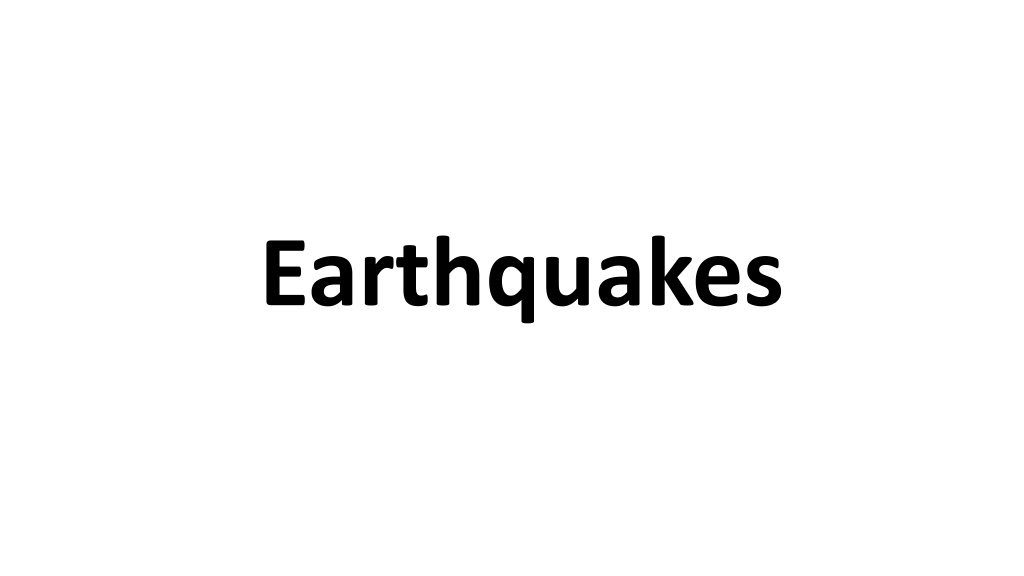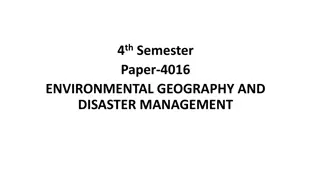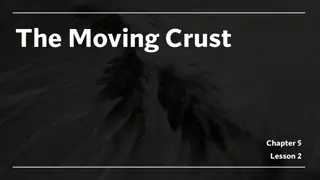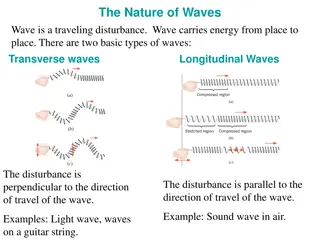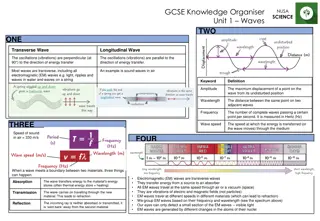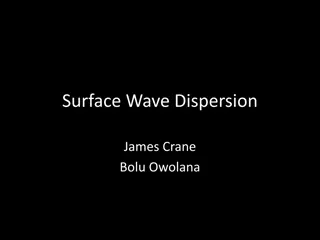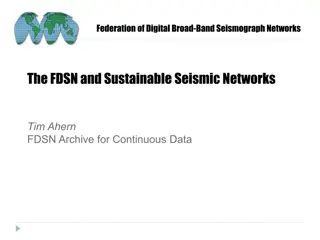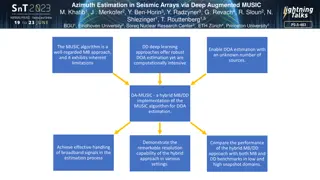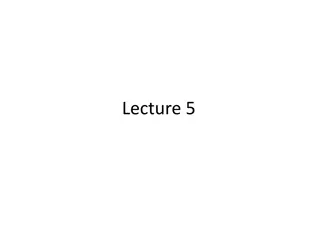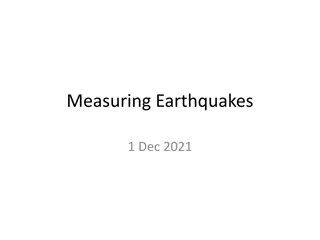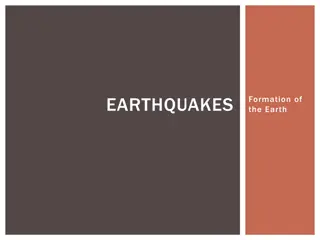Understanding Earthquakes and Seismic Waves
This lecture delves into the nature and origin of earthquakes, discussing seismic waves, measurement techniques, effects of earthquakes on various Earth systems, and the relationship between earthquakes and plate tectonics. The content touches on topics like the impact of earthquakes on biosphere, hydrosphere, and the coastal environment. Geologists' efforts to forecast earthquakes and the study of earthquake waves (seismology) are also explored in detail.
Download Presentation

Please find below an Image/Link to download the presentation.
The content on the website is provided AS IS for your information and personal use only. It may not be sold, licensed, or shared on other websites without obtaining consent from the author. Download presentation by click this link. If you encounter any issues during the download, it is possible that the publisher has removed the file from their server.
E N D
Presentation Transcript
This Lecture will help you understand the nature and origin of earthquakes. We discuss the seismic waves created by earthquakes and how the quakes are measured and located by studying these waves. We also describe some effects of earthquakes, such as ground motion and displacement, damage to buildings, and quake-caused fires, landslides, and seismic sea waves (tsunami). Earthquakes commonly affect other parts of Earth systems. Intense shaking associated with an earthquake not only can cause tremendous damage and loss of life but can also trigger landslides that may disperse pathogenic microbes into the atmosphere and cause additional human health concerns.
Such was the case after the 1994 Northridge, California earthquake. Another effect on the biosphere may be the unusual behavior of animals just before an earthquake, as reported by Chinese scientists. Ground breakage associated with earthquakes may affect the hydrosphere by creating new lakes (sag ponds), increasing groundwater flow from springs, and displacing stream channels. Tsunami generated by submarine earthquakes may cause tremendous damage to the coastal environment.
Earthquakes are largely confined to a few narrow belts on Earth. This distribution was once puzzling to geologists, but here we show how the concept of plate tectonics neatly explains it. As geologists learn more about earthquake behavior, the possibility exists that we will be able to forecast earthquakes. We conclude the chapter with a look at this developing branch of study.
If you have ever bought a watermelon, you know the challenge of picking out a ripe, juicy one without being able to look inside. One trick is to tap the melon gently with your knuckle. If you hear a sharp, clean sound, it is probably ripe; a dull thud indicates that it may be overripe and mushy. The watermelon illustrates two points that can be applied to the Earth: (1) The energy of your tap travels through the melon, and (2) the nature of the melon s interior affects the quality of the sound.
A wave transmits energy from one place to another. Thus, a drumbeat travels through air as a sequence of waves, the Sun s heat travels to Earth as waves, and a tap travels through a watermelon in waves. Waves that travel through rock are called seismic waves. Earthquakes and explosions produce seismic waves. Seismology is the study of earthquakes and the nature of the Earth s interior based on evidence from seismic waves.
An earthquake produces several different types of seismic waves. Body waves travel through the Earth s interior. They radiate from the initial rupture point of an earthquake, called the focus. The point on the Earth s surface directly above the focus is the epicenter. During an earthquake, body waves carry some of the energy from the focus to the surface. Surface waves then radiate from the epicenter along the Earth s surface. Although the mechanism is different, surface waves undulate across the ground like the waves that ripple across the water after you throw a rock into a calm lake.
Two main types of body waves travel through the Earths interior. A (P) wave (also called a compressional wave) is an elastic wave that causes alternate compression and expansion of the rock. P waves travel through air, liquid, and solid material. P waves travel at speeds between 4 and 7 kilometers per second in the Earth s crust and at about 8 kilometers per second in the uppermost mantle. As a comparison, the speed of sound in air is only 0.34 kilometer per second, and the fastest jet fighters fly at about 0.85 kilometer per second. P waves are called primary waves because they are so fast that they are the first waves to reach an observer.
A second type of body wave, called an (S) wave, is a shear wave. An S wave can be illustrated by tying a rope to a wall, holding the end, and giving it a sharp up-and down jerk. Although the wave travels parallel to the rope, the individual particles in the rope move at right angles to the rope length. A similar motion in an S wave produces shear stress in rock and gives the wave its name. S waves are slower than P waves and travel at speeds between 3 and 4 kilometers per second in the crust. As a result, S waves arrive after P waves and are the secondary waves to reach an observer. Unlike P waves, S waves move only through solids. Because molecules in liquids and gases are only weakly bound to one another, they slip past each other and thus cannot transmit a shear wave.
Surface waves travel more slowly than body waves. Two types of surface waves occur simultaneously in the Earth. A Rayleigh wave moves with an up and down rolling motion like an ocean wave. Love waves produce a side-to- side vibration. Thus, during an earthquake, the Earth s surface rolls like ocean waves and writhes from side to side like a snake.
A seismograph is a device that records seismic waves. To understand how a seismograph works, consider the act of writing a letter while riding in an airplane. If the plane hits turbulence, inertia keeps your hand relatively stationary as the plane moves back and forth beneath it, and your handwriting becomes erratic.
Early seismographs worked on the same principle. A weight was suspended from a spring. A pen attached to the weight was aimed at the zero mark on a piece of graph paper. The graph paper was mounted on a rotary drum that was attached firmly to bedrock. During an earthquake, the graph paper jiggled up and down, but inertia kept the pen stationary. As a result, the paper moved up and down beneath the pen. The rotating drum recorded earthquake motion over time. This record of Earth vibration is called a seismogram. Modern seismographs use electronic motion detectors which transmit the signal to a computer.
Over the past century, geologists have devised several scales to express the size of an earthquake. Before seismographs were in common use, earthquakes were evaluated on the basis of structural damage. One that destroyed many buildings was rated as more intense than one that destroyed only a few. This system did not accurately measure the energy released by a quake, however, because structural damage depends on distance from the focus, the rock or soil beneath the structure, and the quality of construction.
In 1935 Charles Richter devised the Richter scale to express earthquake magnitude. Richter magnitude is calculated from the height of the largest earthquake body wave recorded on a specific type of seismograph. The Richter scale is more quantitative than earlier intensity scales, but it is not a precise measure of earthquake energy. A sharp, quick jolt would register as a high peak on a Richter seismograph, but a very large earthquake can shake the ground for a long time without generating extremely high peaks. In this way, a great earthquake can release a huge amount of energy that is not reflected in the height of a single peak, and thus is not adequately expressed by Richter magnitude.
Modern equipment and methods enable seismologists to measure the amount of slip and the surface area of a fault that moved during a quake. The product of these two values allows them to calculate the moment magnitude. Most seismologists now use moment magnitude rather than Richter magnitude because it more closely reflects the total amount of energy released during an earthquake.
On both the moment magnitude and Richter scales, the energy of the quake increases by about a factor of 30 for each successive increment on the scale. Thus, a magnitude 6 earthquake releases roughly 30 times more energy than a magnitude 5 earthquake.
If you have ever watched an electrical storm, you may have used a simple technique for estimating the distance between you and the place where the lightning strikes. After the flash of a lightning bolt, count the seconds that pass before you hear thunder. Although the electrical discharge produces thunder and lightning simultaneously, light travels much faster than sound. Therefore, light reaches you virtually instantaneously, whereas sound travels much more slowly, at 340 meters per second. If the time interval between the flash and the thunder is 1 second, then the lightning struck 340 meters away and was very close.
The same principle is used to determine the distance from a recording station to both the epicenter and focus of an earthquake. Recall that P waves travel faster than S waves and that surface waves are slower yet. If a seismograph is located close to an earthquake epicenter, the different waves will arrive in rapid succession for the same reason that the thunder and lightning come close together when a storm is close. On the other hand, if a seismograph is located far from the epicenter, the S waves arrive at correspondingly later times after the P waves arrive, and the surface waves are even farther behind.
Geologists use a time-travel curve to calculate the distance between an earthquake epicenter and a seismograph. To make a time-travel curve, a number of seismic stations at different locations record the times of arrival of seismic waves from an earthquake with a known epicenter and occurrence time. This graph can then be used to measure the distance between a recording station and an earthquake whose epicenter is unknown. Time-travel curves were first constructed from data obtained from natural earthquakes. However, scientists do not always know precisely when and where an earthquake occurred.
In many regions, bedrock lies at or near the Earths surface and buildings are anchored directly to the rock. Bedrock vibrates during an earthquake and buildings may fail if the motion is violent enough. However, most bedrock returns to its original shape when the earthquake is over, so if structures can withstand the shaking, they will survive. Thus, bedrock forms a desirable foundation in earthquake hazard areas.
In many places, structures are built on sand, clay, or silt. Sandy sediment and soil commonly settle during an earthquake. This displacement tilts buildings, breaks pipelines and roadways, and fractures dams. To avert structural failure in such soils, engineers drive steel or concrete pilings through the sand to the bedrock below. These pilings anchor and support the structures even if the ground beneath them settles.
A magnitude 6.4 earthquake struck central India in 1993, killing 30,000 people. In contrast, the 1994 magnitude 6.6 quake in Northridge (near Los Angeles) killed only 55. The tremendous mortality in India occurred because buildings were not engineered to withstand earthquakes. Some common framing materials used in buildings, such as wood and steel, bend and sway during an earthquake but resist failure. However, brick, stone, concrete, adobe (dried mud), and other masonry products are brittle and likely to fail during an earthquake. Although masonry can be reinforced with steel, in many regions of the world people cannot afford such reinforcement.
When an earthquake occurs beneath the sea, part of the sea floor rises or falls. Water is displaced in response to the rock movement, forming a wave. Sea waves produced by an earthquake are often called tidal waves, but they have nothing to do with tides. Therefore, geologists call them by their Japanese name, tsunami. In the open sea, a tsunami is so flat that it is barely detectable. Typically, the crest may be only 1 to 3 meters high, and successive crests may be more than 100 to 150 kilometers apart. However, a tsunami may travel at 750 kilometers per hour. When the wave approaches the shallow water near shore, the base of the wave drags against the bottom and the water stacks up, increasing the height of the wave. The rising wall of water then flows inland. A tsunami can flood the land for as long as 5 to 10 minutes.
Thanks for Your Attention
